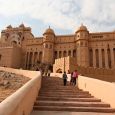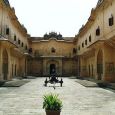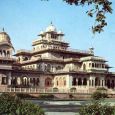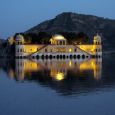Jaipur
Advertisement
By Air
Jaipur Airport is located near Sanganer at a distance of 13 kms from the city of Jaipur. Many domestic airlines connect the city to all the major cities of India including Udaipur and Jodhpur as well. Flights for Delhi and Mumbai run on a regular basis. The airport has been granted the status of an international airport and connects to the foreign cities like Sharjaha and Muscat too.
By Rail
Jaipur Railway Station is a central main station of the state of Rajasthan. The vast rail track of Indian Railways connects Jaipur station with all other cities of India. There are numerous trains which run on a regular basis to and from Jaipur.
By Road
Jaipur is well connected by road to major cities in India. Excellent road network serves people to enjoy a comfortable journey to and from Jaipur. This mode of traveling is quite easy and comparatively cheap. Regular bus services from nearby cities connect Jaipur to the other cities. Deluxe Buses, AC coaches and Government buses are available for the convenience of the passengers.
Jantar Mantar (Observatory)
Built in 18th century by Maharaja Sawai Jai Singh II, the huge masonary instruments were used to study the movement of constellations and stars in the sky. Enormous sun-dial still provide accurate time, which are subject to daily corrections. Timing 9.00 to 16.30 hrs, Entry Fee Rs. 10.00, Phone: 2610494
Jal Mahal Palace
Jal Mahal (or the Water Palace) is on the way to Sisodia Rani Garden. A Rajput style architectured palace sits in the center of the Maan-sarovar lake. The lake is often dry in the summer but winter monsoons frequently turn it into a beautiful lake filled with water hyacinths.
Nahargarh Fort
The species of the area, some of which dissipated over the years, have been reintroduced, so that today the park has Tiger, Leopard, Asiatic Lion (otherwise confined only to the Gir Forest sanctuary in Gujarat), Sloth Bear, Caracal, several species of Deer, Gharial, Crocodile and Otter in its wetlands, Pangolin Jackal, Wild Dog, Wolf, Hyena, Jungle Civet and Fishing Cats, Ratel, Common and Desert Fox, Wild Boar, Rhesus Monkey and Langur, and, of course, a host of avian species.
The old capital of the Kachhwahas stands atop a range of craggy hills. The fort is remarkable as much for the majestic grandeur of its surroundings as for its sturdy battlements and beautiful palaces. It is a fine blend of Hindu and Muslim architecture. The solemn dignity of it red sandstone and white marble pavilions, when reflected in the lake at the foot hill, is a sight to behold. The original palace was built by Raja Man Singh, the additional extensions were built by Maharaja Mirja Raja Jai Singh and Sawai Jai Singh lIthe last Maharaja of Amer, who built a new city called Jaipur, where he shfted his capital in 1727.
Amer Fort
The palace complex is lavishly ornamented and displays the riches of Amer. Sheesh Mahal chamber of Mirrors. Diwan-e-Am or the Hall of Public Audience is a beautifully proportioned hall open on three sides and stands on two rows of ornamented pillars. Diwan e-Khas or the Hall of Private Audience has delicate mosaic work in glass. Sukh mandir is guarded by sandalwood doors inlaid with ivory. Throughout the massive fort finely carved lattice windows, exquisitely painted doorways, halls and finely sculptured pillars crave for attention.
City Palace Museum
The art gallery is located in the Diwan-I-Aam, which literally mean the Hall of public audience. The exhibits here included some very precious and ancient handwritten original manuscripts of Hindu scriptures. Particularly intriguing in miniature copies of Bhagwat Gita made in this manner so that it can be concealed out of sight of Emperor Aurangzeb’s onslaught on Hindu scriptures. Some very delicate miniature paintings in Rajasthani, Mughal and Persian schools on various themes including the Ramayana are very engrossing displays. Visitors must also take a good at preserved painted ceilings. Also on display are elephant saddles called “haudha”.
Between the armoury museum and the art gallery is the Diwan-I-Khas meaning hall of private or selective audience. This is a marble paved pavilion and puts on display the world largest sterling silver object two gigantic silver vessels. These vessels were made for Maharaja Sawai Madho Singh II, who took in along with him filled with water from River Ganga for drinking. As a devout Hindu the Maharaja did not wish to risk polluted English waters. The ceiling also has large chandeliers, which are mostly protected by dust covers and opened only of festive occasions. The Guinness Book of Records accounts it has the biggest silver objects in the world.
The Chandra Mahal Palace is still occupied by the royal family but visitors can visit the ground floor where some exhibits are on display. However the visit here is worthwhile for the exquisite Peacock in the courtyard outside. The present day royal family that takes charge of the museum has done exceptionally well in preserving this legacy in fine state maintenance and presentation. A visits to the palace is enlightening one for its extraordinary occurrence.
Information not available





